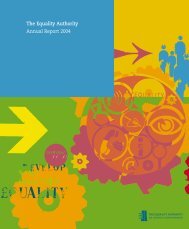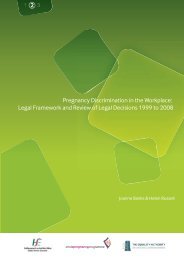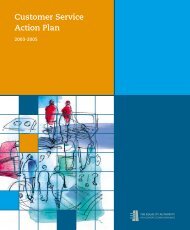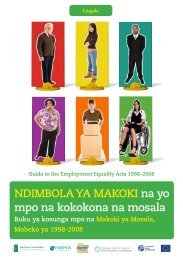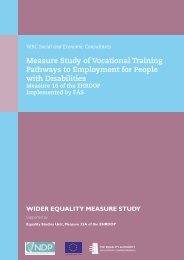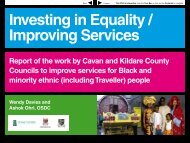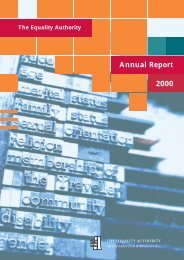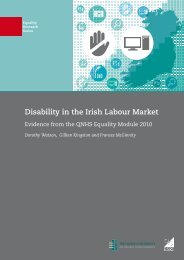Pregnancy and Employment: A Literature Review - Crisis Pregnancy ...
Pregnancy and Employment: A Literature Review - Crisis Pregnancy ...
Pregnancy and Employment: A Literature Review - Crisis Pregnancy ...
Create successful ePaper yourself
Turn your PDF publications into a flip-book with our unique Google optimized e-Paper software.
<strong>Pregnancy</strong> <strong>and</strong> <strong>Employment</strong>: A <strong>Literature</strong> <strong>Review</strong><br />
3.8 Conclusion<br />
There is a growing body of research that analyses women’s transitions back into employment following childbirth.<br />
These studies shed light on the process of re-entry that is not possible with cross-sectional snapshots of the<br />
female population. The research highlights that the decision on if <strong>and</strong> when to return is influenced by a complex<br />
amalgam of personal, job <strong>and</strong> policy factors, which interact with each other to create different sets of opportunities<br />
<strong>and</strong> costs for different women. A woman’s human capital – measured in a variety of ways (education level, prior<br />
occupational position, work experience, prior earnings) – was found to have a strong influence on return-to-work<br />
decisions across a wide range of countries in nearly all the studies reviewed. The positive effects of a woman’s<br />
human capital were found in studies that examined women’s transitions in the months immediately following<br />
childbirth <strong>and</strong> studies that took a wider time-frame across women’s careers. In general, women who had a higher<br />
human capital <strong>and</strong> earning capacity were likely to return to work more quickly than women with lower human<br />
capital. Furthermore, there is little evidence that the effect of a woman’s human capital has declined over time,<br />
despite the substantial changes in women’s labour-market participation <strong>and</strong> education level over the long period<br />
covered by the studies in the UK.<br />
The human-capital effect is likely to be linked to both the stronger financial incentives <strong>and</strong> non-financial<br />
motivations for women in more privileged positions to resume employment. These characteristics are also likely to<br />
correlate with other organisational benefits that encourage a return, such as access to more generous employerprovided<br />
maternity pay <strong>and</strong> greater job security. Women’s individual <strong>and</strong> family characteristics in terms of their<br />
age of birth, number <strong>and</strong> age of other children <strong>and</strong> partner’s characteristics are also found to influence return<br />
decisions. However, in this case, the effects are more varied across countries. This suggests that their influence is<br />
moderated by policy regimes such as the availability <strong>and</strong> cost of childcare, <strong>and</strong> the level of economic dependency<br />
among couples that is encouraged by the tax <strong>and</strong> benefit system.<br />
Job <strong>and</strong> organisational factors are also found to play a role in return decisions. Women in the public sector, those<br />
in permanent positions <strong>and</strong> women with access to flexible working arrangements are all more likely to make<br />
a quicker return to employment. These findings highlight the type of employer arrangements that increase<br />
retention following childbirth. Employer provisions also interact with state provisions for maternity leave <strong>and</strong><br />
for flexible work options. In countries where government-provided benefits are lower (for example in the US),<br />
employer benefits become increasingly important. Government-provided maternity <strong>and</strong> parental-leave schemes<br />
have been instrumental in maintaining women’s link to employment following childbirth. In the absence of such<br />
provision, women’s probability of returning to employment is much lower <strong>and</strong> employment gaps of many years are<br />
much more common.<br />
Return-to-work decisions are not simply driven by policies, socio-demographic characteristics <strong>and</strong> job<br />
characteristics; individual preferences also play a role, particularly women’s orientation towards family. The extent<br />
to which women’s preferences can be exercised is, however, related back to both her individual resources <strong>and</strong> the<br />
labour market <strong>and</strong> policy context in which she is located.<br />
PAGE 35




